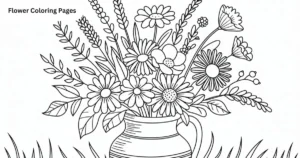Peonies are stunning, perennial flowers that bring beauty and color to any garden. However, knowing when and how to cut them down is key to ensuring their health and future blooms. Proper timing allows the plant to rest and prepare for the next growing season.
Cutting peonies at the right time helps prevent diseases, pests, and overcrowding, while promoting vibrant flowers year after year. In this guide, we’ll explore the best practices for cutting down your peonies, so they can thrive and continue to brighten your garden.
Understanding Peony Growth Cycles
Peonies follow a natural growth cycle throughout the year. In spring, they begin to grow, producing fresh green stems and leaves. By the time summer arrives, peonies are in full bloom. As fall approaches, the plant’s growth slows down, and it starts preparing for winter. Understanding this cycle will help you know when to trim them.
The best time to cut peonies depends on where you are in the growth cycle. It is important not to cut them too early, as this can harm the plant. Instead, wait until the leaves and stems start to yellow or die back naturally before cutting them down.
When Peonies Should Be Cut Back
The ideal time to cut back your peonies is in the fall after the first frost. Once the leaves and stems begin to brown, it signals the plant is entering dormancy. At this point, cutting back helps remove old growth, which can attract pests and diseases over the winter months.
You should cut down the plant to just a few inches above the ground. Be careful not to damage the roots or the crown of the plant. Trimming peonies properly at this time ensures that they rest properly during the winter and are ready to grow again in the spring.
Why Timing Matters
Timing is crucial because cutting your peonies too soon can prevent the plant from storing energy in its roots for the next growing season. Peonies need time to prepare for winter, and cutting them down too early can weaken the plant. Waiting until fall ensures they are fully ready to rest.
On the other hand, leaving the stems and leaves standing through winter is also not ideal. Dead and decaying plant material can become a breeding ground for disease. It is always best to remove them once the plant has fully entered dormancy.
Signs That Peonies Are Ready to Be Cut Back
Before cutting peonies down, watch for signs that the plant has finished growing for the season. The leaves will turn yellow, and the flowers will have dried out. Once the foliage is no longer vibrant and the plant has slowed its growth, it’s time to prepare for trimming.
However, don’t wait too long. If the plant stays green and does not start to die back naturally, it may be due to environmental factors. Still, it’s a good idea to cut them when the foliage is noticeably fading, ensuring the plant can rest properly.
Cutting Peonies in the Spring
Although it’s best to cut peonies back in the fall, some gardeners choose to do it in early spring. Spring trimming can help remove any dead or damaged growth from the previous season. However, this should only be done when new growth is visible and frost is no longer a concern.
Cutting peonies in the spring is not harmful, but it’s a less common practice. If you do choose this method, make sure not to cut into the crown or roots. Only trim the dead stems and foliage, and leave the healthy buds to bloom.
How to Properly Cut Down Peonies
When you cut peonies down, always use sharp, clean tools to avoid damaging the plant. A pair of garden shears or pruners should be sufficient. Start by removing any dead flowers, stems, or leaves, then work your way down to the base of the plant.
Cut the stems about 3–4 inches above the ground. Be sure not to cut too close to the crown of the plant. This can cause harm to the plant and impact future growth. Proper cutting ensures that the plant can rest and recharge for the next growing season.
What Happens if You Don’t Cut Peonies Down
If you neglect to cut your peonies down, the dead foliage can become a home for pests and diseases. It can also prevent new growth from emerging in the spring. While the plant may still bloom, it will not be as healthy or vibrant as it could be.
Leaving the plant untouched can also make it more difficult to manage in the future. Overgrown peonies can crowd the garden and compete for space with other plants. Therefore, regular pruning is essential for maintaining healthy, long-lasting peonies.
Read More: When Is the Best Time to Transplant Peonies?
Caring for Peonies After Cutting Them Down
After cutting your peonies down, it’s important to care for the plant to ensure it remains healthy. You can mulch around the plant to protect the roots from winter cold. A layer of compost or wood chips helps keep the soil moist and insulates the plant against harsh conditions.
Additionally, keep an eye out for any signs of disease or pests. If you notice any, take appropriate action to prevent it from spreading. Good care after cutting ensures that your peonies are ready for a fresh start in the spring.
Conclusion
In conclusion, cutting down peonies at the right time is crucial for their long-term health and blooming potential. Trimming them in the fall, after the first frost, allows the plant to enter dormancy and conserve energy for the next growing season. Waiting until the foliage naturally fades ensures the plant is fully prepared for winter.
Proper care and timely pruning prevent pest problems and promote strong growth. By following these simple steps, your peonies will thrive, offering beautiful blooms year after year. Remember, the key is patience and knowing the perfect moment for cutting them down.
FAQ’s
When is the best time to cut down peonies?
The best time is in the fall after the first frost.
Can I cut peonies back in the spring?
Yes, but it’s less common and should only be done once new growth appears.
What should I use to cut peonies?
Use sharp, clean garden shears or pruners.
Should I remove all the leaves when cutting peonies?
Only remove dead or damaged leaves, leaving healthy buds intact.
What happens if I don’t cut peonies down?
Leaving them can lead to pest problems and hinder new growth.









